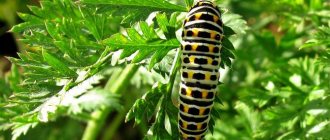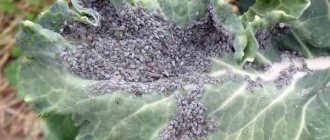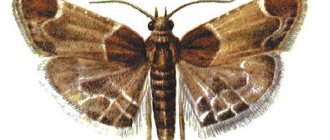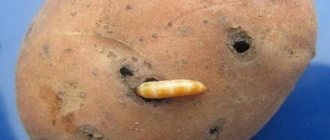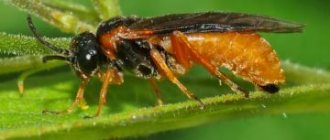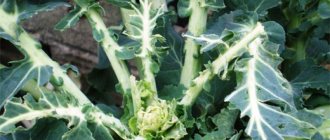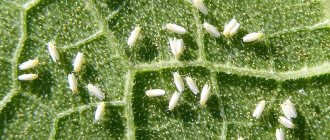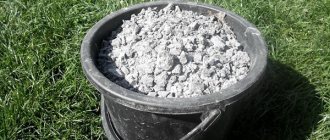Spider mite
This insect most often appears on seedlings that are grown in greenhouse conditions and greenhouses. However, sometimes spider mites can also be seen on cucumber bushes in open ground.
When this pest appears, a web begins to appear on the surface of the cucumber leaves. To make sure that the seedlings have been attacked by spider mites, it is recommended to carefully examine the lower part of the leaves, since insects most often hide there.
Such ticks reproduce very quickly, since their female can lay about two hundred eggs in one season. Literally a few weeks after their appearance, pests of cucumber seedlings suck out all the juice from the leaves, which leads to the slow death of cucumbers.
How to protect cucumbers from spider mites
Pests must be controlled immediately after their appearance in order to protect the seedlings from death. Greenhouse plants are protected from this insect by two main methods:
- Regular watering. The mite does not like highly moist soil and therefore does not reproduce in conditions of high humidity.
- Planting plants. It is recommended to plant carrots, parsley or dill near the cucumbers. They attract ladybugs, which feed on spider mites.
Mites are not covered with a protective covering and therefore it is recommended to treat cucumber seedlings with special caustic compounds that will clear the cucumber seedlings of them. It is recommended to create treatment products from components that are harmless to humans. You can spray the seedlings with the following solutions:
- Liquid made from soap and ground pepper. To prepare the drug, add the same amount of soap and ground pepper to 10 liters of water. Then 40 grams of ash and chopped onion are added to the mixture. Before watering the plants, it is necessary to strain the resulting liquid through cheesecloth.
- Capsicum remedy. Add 80 grams of ground hot pepper to 5-7 liters of water. The mixture should be infused for at least a day, after which it will be necessary to water the cucumber bushes twice a week.
Some gardeners do not use folk remedies and use chemicals instead. It is recommended to use such products only in the first 2-3 weeks after planting in the soil, before fruit formation begins.
Spider mites on cucumbers
Spider mites are small arachnids whose presence on plants is revealed by a thin white web (at the initial stage of infection, usually on the underside of the leaves, then moving to the stems and fruits). Alas, the mite’s actions are not limited to weaving a web - the pest, both at the larval and adult stages, sucks the juice from plants, which is why the leaves first become covered with light spots, and then completely turn yellow, dry out and fall off.
Spider mites prefer dry air at high temperatures, so they most often harm cucumber plants with insufficient watering in dry summers or with rare ventilation in the greenhouse. This arachnid reproduces very quickly, so if the gardener is inactive, it can quickly infect all nearby plants.
Prevention of the appearance of spider mites on cucumbers includes the destruction of weeds (quinoa is especially dangerous in this regard), digging up the soil, regularly removing and burning damaged leaves, timely watering and ventilation of plantings.
Measures to combat spider mites on cucumbers boil down to spraying the plants with insecticides Akarin, Fufanon-Nova, Karbofos according to the instructions.
If you are a supporter of a “chemical-free garden,” try traditional or biological methods of combating spider mites. So, you can treat cucumbers with Fitoverm, Bicol or Bitoxibacillin (according to the instructions), and also populate the plantings with the predatory mite Phytoseiulus. Popular rumor recommends spraying plants against ticks with warm water with the addition of soap (40 g per 10 l) or an infusion of garlic or onion peels (200 g of peel per 1 l of water).
- Spider mites - how to recognize them on plants and fight them effectively
The smallest pests sometimes cause us the biggest problems. Spider mites in the garden and vegetable garden are dangerous for all crops.
Snails and slugs
Slugs and snails are quite common in the gardens of summer residents. During the day, you may not notice them on cucumbers, since these pests prefer to crawl out at night or in cloudy weather. If a slug or snail appears on a plant, it eats cucumber leaves and even their fruits. At first they start with the lower leaves, but over time they move to the rest. If you do not protect the seedlings from slugs and snails in time, they will completely destroy the cucumber bushes.
See also
Characteristics and description of the Far Eastern cucumber, its cultivationRead
How to protect cucumbers from slugs and snails
Some vegetable growers do not know what to do to get rid of such pests. There are several fairly effective ways to protect seedlings in a greenhouse and outdoors:
- Copper tapes. To prevent snails from eating the leaves of cucumber seedlings, it is necessary to spread copper strips near the plants. During contact with such material, mollusks receive a small electrical charge, from which they can die.
- Chemicals Thunderstorm or Meta. If the use of copper tapes does not help, then you will have to spray the cucumbers with special chemicals. Treating cucumbers against pests should be done very carefully. It is not recommended to use very concentrated mixtures and therefore chemicals must be diluted with water before use. Manufacturers claim that the use of these drugs is absolutely harmless for people.
Black aphids on cucumbers: traditional methods of pest control
Many gardeners prefer not to use chemicals in their garden beds so as not to “poison” the fruits. If there are not very many insects yet or when the cucumbers have begun to bear fruit, the following folk remedies will help:
- Herbal infusions. Aphids do not like the aroma of celandine, dandelions, yarrow, onions, garlic, horseradish, tomato tops and potatoes.
- Infusion of red hot pepper (2-3 pcs.) with the addition of a couple of drops of iodine and 0.5 tbsp. ash.
- Mustard powder solution (100 g per bucket of water). To make it stick to the leaves better, you need to add soap and a little sunflower oil.
- Spraying cucumbers with soda solution.
- Dilute ammonia (50 ml per 10 liters of water).
- Soap solution.
It is necessary to spray cucumbers on both sides of the leaves. Several treatments will be required, but it is better to use a new product each time so that the aphids do not get used to it.
Trips
Quite often, leaves on cucumbers are eaten by tobacco thrips. These white insects begin to multiply in the soil and eventually move to cucumber seedlings. Cucumbers with thrips on their leaves will not survive long. This pest gnaws leaves and feeds on the juice of cucumbers, which over time leads to serious deformations of the fruits and stems. Also, during cultivation, large light spots may appear on the leaves.
How to deal with thrips
Thrips are very resistant insects and therefore the fight against them can take a long time. Cucumber pest control technology can be carried out using the following means:
- Adhesive tape. You can protect cucumbers from pests in a greenhouse using adhesive tape. Adults often fly and therefore there is a chance that they will fall into such a trap.
- Watering. Regular watering works great against thrips. Such pests of cucumber seedlings do not like high humidity and therefore it is recommended to periodically water the plant leaves with a hose.
- Fitoverm. When the above control methods do not help, treat the cucumber bushes with Fitoverm. This product should be used only in the evening at temperatures above 20 degrees.
Worms
Another common problem when growing cucumbers is worms. They affect the performance of the root system, as they can start gnawing on the root of the cucumbers. If you do not get rid of the worms on the roots in time, the plant will die.
How to protect cucumbers from worms
To protect roots from worms, several of the most effective means to combat them are used:
- Baosia seeds butyration. Using flour made from the seeds of this Malayan plant, you can quickly get rid of pests in the soil. These seeds contain a substance called maurin. When feeding, it is this that affects the worms after entering their body. When feeding plants with flour, you should use no more than 200 grams of flour per square meter of land.
- Copper sulfate. To protect cucumbers from worms, spray the area with copper sulfate. It is not recommended to be used dry, so you should mix it with water.
- Derris. A very effective drug, often used to control pests. Before using it, you need to prepare a working solution. To do this, 20 grams of the product are mixed with 5 liters of water and infused for about 40 minutes. The area should be treated with Derris twice a month.
Whitefly
Many gardeners complain that their cucumbers suffer from whitefly. This small insect is very reminiscent of butterflies. Whitefly caterpillars and adults are quite small - 2-3 mm in length and therefore it is quite difficult to notice them on cucumber bushes.
Whiteflies spend most of their lives eating leaves, which eventually begin to dry out.
The main sign of the presence of pests on seedlings is a weak coating located on the lower half of the leaves. A fungus begins to develop in the affected areas of the leaves, due to which the seedlings can become infected with one or another disease. After a few days, signs appear on top. A huge number of small holes appear on the top leaf plate.
See also
Description of the Kadrill cucumber variety, features of cultivation and careRead
The insect is often found in greenhouses, as it breeds only in warm conditions with high humidity. Whiteflies are also found in open ground, but much less frequently.
How to treat cucumbers to remove whiteflies
It is very difficult to save cucumber bushes from this insect. If it has attacked only a few bushes, then it is easier to simply get rid of the infected plants so that the insect does not have time to spread to neighboring seedlings. However, for larger scale distribution this option is not suitable. In this case, you can use:
- Sticky tapes. Fly catching tapes are great for this. They are hung throughout the greenhouse above each row of cucumbers.
- Planting plants. For example, some gardeners plant Boveria mushrooms near cucumbers to protect them from whiteflies.
- Spraying. You can regularly spray cucumber bushes with water from a hose. In this case, the pressure must be powerful enough to wash away all insects from the leaves.
Whitefly on cucumbers
These small insects are a “relative” of aphids and behave in almost the same way on plants, being a serious pest of garden crops both in the greenhouse and in the open ground.
The whitefly settles in colonies on the underside of leaves and reproduces very actively, laying larvae. Like aphids, it feeds on plant sap, so the symptoms of plant damage by these insects are similar - the appearance of whitish spots on the leaves, their curling, chlorosis, necrosis and falling, weakening of the plants in general.
Like aphids, whiteflies also secrete a sweet liquid and contribute to the appearance of sooty fungus, powdery mildew and gray mold on tomato plants, and are also a carrier of some viral diseases.
Prevention of the appearance of whiteflies on cucumbers includes annual disinfection of the soil in the greenhouse (in winter it can be frozen by opening the doors and vents), regular weeding of the area from weeds, collection and destruction of plant debris and litter, planting whitefly-repellent plants (mint, marigolds) next to the cucumbers and so on.).
Measures to combat whitefly on cucumbers include treating plantings with folk remedies at the initial stages of infection and using chemicals in more advanced cases. Among the folk remedies against whiteflies, we can recommend spraying the plants with a soap solution (1 part laundry soap to 6 parts water) and hanging glue traps in the greenhouse. Effective industrial drugs against this insect are Actellik, Biovert, Iskra Zolotaya, etc. It is important that the whitefly is able to quickly develop immunity to chemicals, so they have to be changed from time to time.
- How to get rid of whiteflies in a greenhouse - effective methods of control
Take note of our tips for dealing with this annoying pest.
Root nematode
The root-knot nematode is the most dangerous pest that can be encountered while growing cucumbers. Many people are interested in what damage this pest causes to the plant. The nematode quickly penetrates the root system of cucumbers and disrupts its integrity. The absorption capacity of the roots may also deteriorate by 2-3 times. Over time, the cucumber bushes stop growing and gradually die.
Pest control methods
Many experts advise that when a nematode appears, immediately get rid of infected cucumbers before the pest begins to spread to other crops on the site. However, not everyone wants to lose their cucumber harvest and therefore try to cure the bushes. In this case, we fight the nematode using the following methods:
- Heat treatment. Bushes treated thermally can be saved from nematodes. It is recommended to carry out this procedure during transplantation of seedlings or when the cucumber bushes are at rest. To do this, the roots of the seedlings must be soaked in warm water for 20-40 minutes. After the procedure, the cucumbers should be immediately placed in a container with cold water so that it cools quickly.
- Chemicals. Chemicals are used if heat treatment does not help cure the seedlings. Many people do not know which chemicals are best to use in treatment. To do this, it is better to use Actofit or Fitoverm, produced in powder form. During use, these products are scattered on the ground and mixed with the soil. Some people dilute them with water and spray the resulting liquid onto the plants. Chemicals must be used very carefully in greenhouses. After using them, it is recommended to ventilate the room for several hours.
What to do - how to fight and get rid of the pest
What folk remedies to spray
If cucumbers affected by aphids have an ovary, then the use of chemicals is not recommended. Their components will be absorbed into the root system and fruits, as a result of which the entire crop will have to be disposed of. Instead of chemicals, you can use folk remedies, which are also quite effective, but at the same time safe.
Hot pepper
Small pests simply cannot tolerate hot peppers. To make the product correctly, you need to take 2-3 pods and chop finely. Add to 10 liters of water. Place the container with the solution in a warm room.
After 24 hours, filter the broth, and then add the following components:
- wood ash – 150 g;
- liquid soap – 60 ml;
- iodine – 2-3 drops.
Pour the resulting mixture into a spray bottle and treat the upper leaves and stems. At the same time, make sure that the solution does not get on the root system. If you don’t have hot pepper at home, then store-bought black or red peppers are an excellent alternative to the wall. But you just have to increase the portion 2-3 times. Be sure to add 50 g of tobacco dust to the prepared solution. This article will tell you how to treat plums against aphids.
Garlic
Aphids cannot tolerate the aroma that comes from garlic. To prepare the solution, take 500 g of raw material, chop it finely, fill a 3-liter jar with water, and add the garlic.
Cover with a lid and wait 5 days. Use the prepared solution to treat the bushes.
Mustard
You can destroy small pests with the help of such a burning product as mustard. It is necessary to dilute 10 g of raw material in 1 liter of water. Leave for 2 days. Place 800 ml of distilled water into the prepared infusion. Treat the plant with a spray bottle. You can also add 70 g of soap so that the insects disappear in 2-3 days. It will also be useful to learn more about how to poison the Colorado potato beetle with mustard and vinegar.
Infusion of celandine
To prepare, take 300 g of dry raw materials. Moreover, you can use leaves, stems and roots. Finely chop everything, put it in a bucket and add 10 liters of water. Cover with a lid and place the container in the sun, filter after 2 days, pour into a container with a spray bottle and treat the bushes. It is also worth learning more about how to use celandine.
Due to the fact that celandine releases poison, you need to wear rubber gloves when preparing the solution. But knives and other equipment need to be washed with soapy water.
Dandelion solution
You need to take 400 g of finely chopped roots and 600 g of chopped dandelion leaves. Fill in all 10 liters of water. Leave for 3 hours, and then you can start processing the cucumbers. It will also be useful to learn about how cabbage is controlled using folk remedies, including the method indicated above.
Yarrow decoction
You need to take 900 g of fresh grass and 2 liters of boiling water. Combine everything, cover the container with a lid and wait 1 hour. Before use, the concentrate must be diluted with water in an amount of 10 liters. Approximately 1 liter of solution will be needed per 1 m2.
Bow arrows
Take half a bucket of raw materials and fill everything with water. Add 5 drops of iodine and 2-3 crystals of potassium permanganate to the prepared solution. The resulting liquid should be light pink. It may also be useful for you to learn about how to treat cabbage against fleas and aphids.
Tobacco and horseradish
If there is a massive pest attack, then you need to take 400 g of shag and pour 10 liters of hot water. Wait 2 days, covering the container with a lid. Before using the prepared solution, add 80-100 g of laundry soap, previously ground on a grater.
Tobacco can also be used in other ways. Simply scatter the powder over the beds. This manipulation should be carried out in the evening. After this, stop watering for 2-3 days.
Horseradish infusion
Take 7-8 roots of the plant, wash and finely chop, place in a container and add 3 liters of hot water. Leave for 3 hours and filter. Do not throw away the cake, but combine it with a new portion of distilled water. Wait another 3 hours. Combine the first concentrate with the second. Before using the solution, you need to take 5 liters and 200 ml of horseradish tincture. In this way you can very well remove the pest from the cherry.
Potato and tomato tops
Take side or weak shoots from a young plant. Finely chop them and add water. For 10 liters of water there are 1.5-3 kg of raw materials. Leave for 24 hours. How to fight strawberry pests with folk remedies, and what products should be used, can be seen in this material.
Wood ash
For 10 liters of water there are 60 g of powder and 100 g of finely chopped soap. Stir all components until they are completely dissolved.
Infusions and decoctions are prepared from the ash, mixed with tobacco dust or soap. Each product has a beneficial effect on plantings and protects them from harmful insects throughout the summer season.
You can add mint or tea tree esters to existing decoctions or tinctures. Due to the pungent aroma, insects will leave the cucumbers. It will also be useful to learn about the benefits of ash as a fertilizer.
Chemicals
If there is a massive infestation of aphids, and traditional methods have not given the desired effect, then you can try the following chemicals:
- Fitoverm. This drug is bottled in 2, 4, 10 ml and 5 liter bottles. The active component is aversectin. It is effective in combating various types of soil fungus. Aversectin affects the nervous system of the parasite, as a result of which it dies.
- Aktara . This product contains the active ingredient thiamethoxam. You can purchase it in the form of a suspension or granules. To use the solution to treat cucumbers, you need a sprayer. By clicking on the link you can learn more about Aktara, a remedy for the Colorado potato beetle.
- Metaphos . When using this drug, make sure that the weather is calm. Its advantage can be considered a long-lasting effect.
- Arrow . This drug is packaged in 50 g sachets. It will be enough to prepare 10 liters of solution. The active substance is bitoxybacillin. This is a gray powder that contains bacterial spores that cause damage to insects. After using the solution, the aphid gets sick and dies. You can completely peel cucumbers in 10 days.
- Intavir . This drug contains an active ingredient called cypermethrin. It is contained in a concentration of 4%. When the parasites eat the solution, they become paralyzed and die. You can purchase the product in the form of tablets or powder. They must be used to obtain a solution for spraying. Using this drug, you can increase the plant’s resistance to various pests, including aphids.


